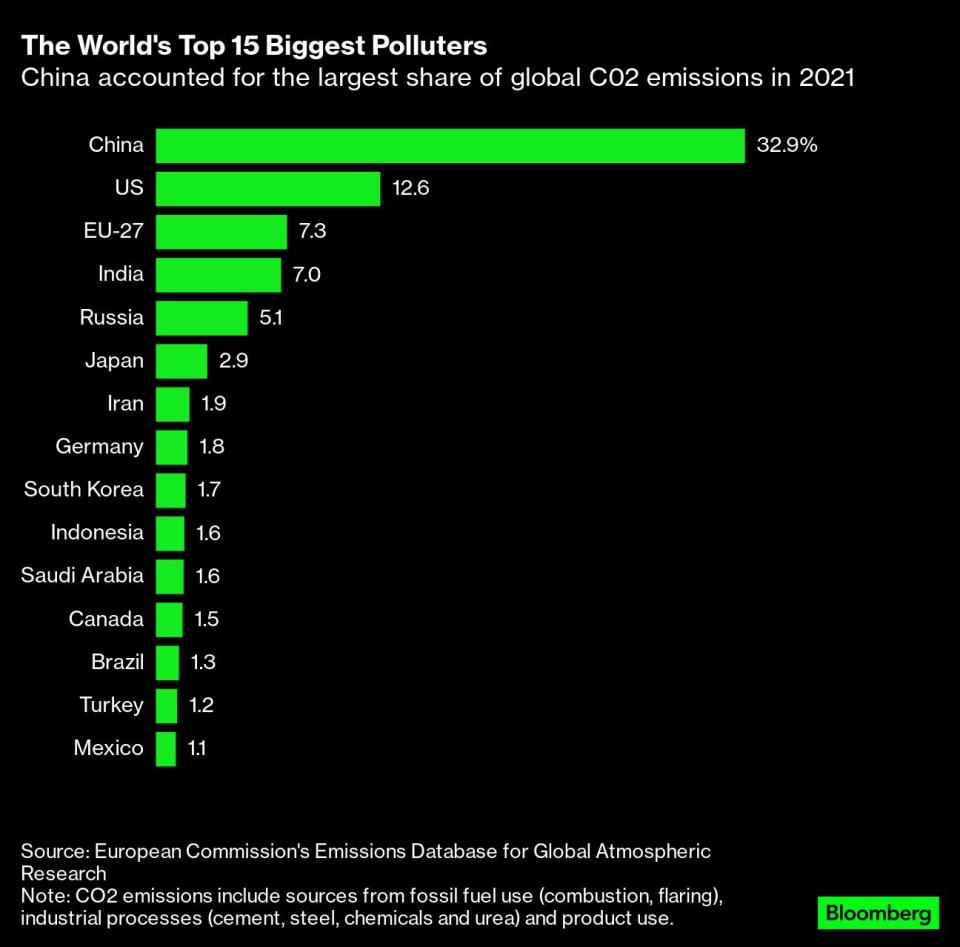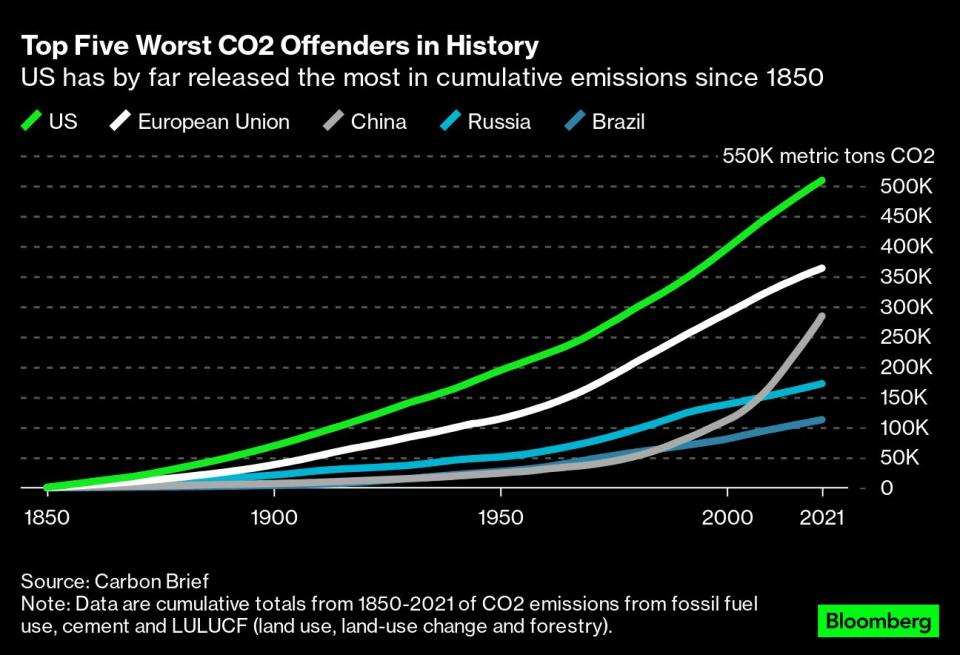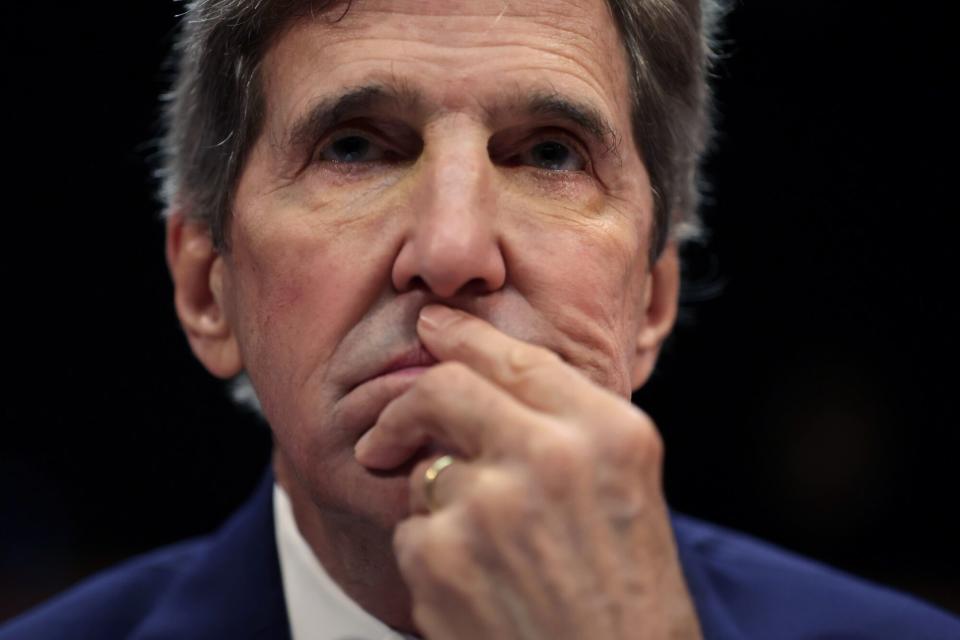US, China Seek Thaw on Climate as World Broils Under Extreme Heat
- Oops!Something went wrong.Please try again later.
(Bloomberg) -- US climate envoy John Kerry was resolute as he sat across from his Chinese counterpart in Beijing on Monday: The global warming crisis “cannot be solved” without both nations working together, he said.
Most Read from Bloomberg
Singapore Passport Is World’s Most Powerful, Replacing Japan
Tesla Investor Rode a 14,800% Gain Thanks to 27-Year-Old Analyst
Morgan Stanley Moves 200 Tech Experts From China on Data Law
Meet the Billionaire Who Convinced Messi to Pick MLS Over Saudi Arabia
Countries are “looking to this meeting to see if we can move beyond the real differences we have,” Kerry said of negotiations between the two superpowers, held as heat waves bake much of the planet and temperature records shatter. “Of all the topics in the world, there can’t be differences on this.”
While talks got underway, some 84 million Americans were under heat warnings and advisories, and Chinese state media reported the Xinjiang region had logged its hottest-ever temperature.
The three days of talks aim to carve a path for collaboration on climate change through the rocky terrain of the US-China relationship, amid disputes over human rights, trade controls and Taiwan. They follow on the heels of visits to Beijing by US Treasury Secretary Janet Yellen and US Secretary of State Antony Blinken aimed at tamping down tensions between the rivals.
For his part, Chinese climate envoy Xie Zhenhua on Monday cast the talks as a chance to pursue “substantial” outcomes. Simply the resumption of regular US-China dialogue on climate would be a step forward, experts say.
A positive result would help guard against an unraveling of the relationship the next time it is tested by a wayward balloon or a US official’s visit to Taiwan. The idea is “to help protect against the relationship spinning out of control whenever there’s a geopolitical fracas,” said Thom Woodroofe, founding director of the Asia Society’s China Climate Hub.
It also would inject momentum into global climate talks four months before the critical COP28 summit in Dubai. From the 2015 Paris Agreement to a global pact in Glasgow six years later, almost every major recent diplomatic achievement on climate has come only after a US-China pronouncement paved the way.
“It’s always an enormous boon to the multilateral process when the two are talking and finding ways to find new ways to get in alignment and move their engagement forward,” said David Waskow, director of the World Resources Institute’s international climate initiative.
Even as a matter of carbon math, the countries are essential to climate progress. China is the world’s No. 1 greenhouse gas emitter today. But the US, currently No. 2, has cumulatively released more of the planet-warming pollution than any other nation, after burning fossil fuels for decades to drive its economic growth.
A fragile ‘oasis’
But the work of finding that common ground — unfolding in conference rooms atop the state-owned Beijing Hotel that overlooks Tiananmen Square — is not happening in isolation. Though diplomats may try to make climate an oasis in US-China relations, an oasis surrounded by deserts will eventually “become desertified” too, as Chinese State Councilor Wang Yi observed two years ago.
The core problem is that “each side defines the other as its principal strategic threat,” leaving little room for possible concessions that will be viewed as a capitulation, said David Lampton, a professor emeritus at Johns Hopkins-SAIS and former president of the National Committee on US-China Relations. “When you define the competition with China to be existential — the principal long-term threat to American interests and values — every other arena in the relationship becomes conflictual.”
Expert observers see a big bilateral breakthrough this week as unlikely. Kerry’s team had hoped China might release its strategy for limiting methane emissions, already drawn up in response to a joint pledge with the US. Methane has far more short-term warming impact than carbon dioxide, one reason it has become a top US priority in negotiations with China in recent years, and China committed to developing a joint methane strategy with the US before last November’s United Nations climate talks. Yet while Xie said a draft had been assembled, it was never publicly released.
But Woodroofe said the very fact that the methane plan is foremost on the US wish list makes it politically difficult for China to move forward on. “That just looks like presenting your homework when the foreign barbarian comes to collect it,” he observed. “It doesn’t look like you’re a geopolitical equal.”
That tension hangs over all the talks. The Chinese negotiators will be “very sensitive to not looking like they’re making any concessions to the US or the US forced them to do anything,” said Alden Meyer, a senior associate with research group E3G.
Both parties also face an undeniable reality: It’s getting harder to wall off climate as a diplomatic issue, especially in a global competition to build the clean tech of the future. “All the economic issues are now bound up with climate action,” Waskow noted.
The US imposes tariffs on Chinese-made solar panels and helped advance a Group of Seven plan to bolster critical minerals security seen as a bid to curb China’s dominance as a supplier for the materials used in semiconductors, electric vehicle batteries and other technology. Beijing wants to lower trade barriers on its supply chain of goods essential to the energy transition.
There are clashes on the core issues of climate diplomacy, too, from how quickly nations should move to stifle their own emissions to who should pay to help vulnerable countries deal with the ravages of intense storms, droughts and flooding.
Consider China’s surge in building coal power plants. New permits hit a seven-year high last year. In 2022, China permitted the equivalent of two new coal power plants per week, more than double the year before and six times as much as all of the rest of the world combined.
Although that coincides with skyrocketing investments in wind and solar, it is a frustration to the US and other nations that want to move more rapidly to cut greenhouse gas emissions in an attempt to keep warming within the Paris Agreement threshold of 1.5C. The world has already warmed 1.2C since the pre-industrial era.
China has committed to peak its own emissions before 2030, though it could hit that point as soon as 2023 to 2024, said Lauri Myllyvirta, lead analyst at the Centre for Research on Energy and Clean Air.
Another thorny issue is China’s designation in UN climate deliberations as a developing country, which has served to limit its formal financial contributions to nations bearing the brunt of climate-fueled disasters. That’s an irritant to the European Union, US and other nations that would like to expand the pool of donors for climate aid, and ensure a new program for compensating victims is widely funded.
Yet on a per capita basis, China has only a medium gross domestic product — reflecting the wide variations in wealth across the sprawling nation of 1.4 billion people, said Zhang Haibin, deputy dean of Peking University’s School of International Relations. “As far as I’m concerned,” labeling China as a developed nation is “not reasonable,” he said.
Kerry-Xie relationship
Even so, in the corridors of the Beijing Hotel, bedecked with ancient vases and inlaid art, there’s a sense that this could be a brief window for the countries to make progress. Domestic politics will increasingly constrain Biden as the 2024 campaign season heats up – and hawkish anti-China rhetoric along with it.
“Next year we will see deterioration” because of elections in the US and Taiwan, said Yun Sun, director of the China program at the Stimson Center. “But at least for now, the two powers are trying to build some positive momentum — a higher floor, if you will,” she said.
In talks with China's Premier Li Qiang and the country's top diplomat, Wang Yi, on Tuesday, Kerry argued that climate can be an opening for better relations. "We are very hopeful that this can be the beginning not just of a conversation between you and me, and us on climate change, but that we can begin to change the broader relationship," Kerry told Wang.
Wang, in turn, stressed that cooperation on climate takes place under the broader banner of China-US relations. But the negotiations currently taking place show "the two sides are serious," Wang said. "China and the US need to talk to each other."
This week’s meetings may be the beginning of the end of an era in US-China climate diplomacy. Kerry and Xie, his counterpart, are in their 70s and nearing the end of their careers. Xie’s travel has also been restricted after a stroke. The two men have a roughly 25-year diplomatic relationship that’s been key to forging bilateral agreements. The 2015 Paris Agreement might not have come to fruition if Kerry and Xie hadn’t been able to find common ground.
Years later, during the 2021 UN summit in Glasgow, Xie and Kerry met dozens of times to hammer out what would become the two countries’ “Glasgow declaration” — a joint agreement to establish a working group on climate, combat deforestation and tackle methane emissions. Some of the agreement’s language on a phase-down of coal — instead of phasing it out altogether — was adopted in the final summit pact. The compromise represented a weakening of commitment, but it may also have prevented the accord from falling apart.
“It’s a blessing but it is also a curse that the bilateral climate engagement hinges so much on these two critical individuals,” said Li Shuo, a senior global policy adviser for Greenpeace East Asia. “It is a blessing in the sense they are very experienced and so dedicated. But on the other hand, this is critical engagement and a critical issue that goes beyond the bilateral relationship — and two individuals can only carry so much.”
One possible outcome is that both sides will agree to formally resume talks and resuscitate the joint working group they agreed to create in 2021. After then-House Speaker Nancy Pelosi’s visit to Taiwan last August, climate negotiations were suspended and the working group put in limbo.
Veteran climate negotiators said that even a pledge to keep talking, especially if it came in the form of a joint statement, would represent progress. It would also be a high-water mark in the spate of visits by high-level US officials to China.
This week’s talks could foster pronouncements at the UN General Assembly in September and the Asia-Pacific Economic Cooperation leaders’ summit in California in November that Chinese Leader Xi Jinping is expected to attend, as well as the UN climate summit in Dubai at the end of the year.
As Kerry was preparing for the trip, word came that US Commerce Secretary Gina Raimondo’s emails had been accessed by hackers US officials said were based in China. And hours before he left Washington, lawmakers pressed Kerry to raise the issue of Mark Swiden, a Texan the US says has been “wrongfully detained” by China on trumped-up drug charges.
In the turbulent US-China relationship, a single misstep can derail forward motion. Yet the need to bring down global emissions is urgent, scientists say. The UN’s Intergovernmental Panel on Climate Change has warned that the Paris Agreement goal of limiting warming to 1.5C is almost out of reach. The world is currently on a trajectory to heat up by 2.7C, a level experts say would lead to catastrophic impacts.
Human politics may be slow, Lampton of Johns Hopkins observed, but climate change isn’t waiting for us.
That sense of urgency anchored Kerry’s appeals Monday. “My friends, this is not a political issue,” Kerry said, the day after China recorded a new record high temperature of 52.2C (126F). “This is not a bilateral issue. This is not an ideological issue. This is real life unfolding before our eyes as a consequence of choices we make or don’t make.”
Most Read from Bloomberg Businessweek
©2023 Bloomberg L.P.




